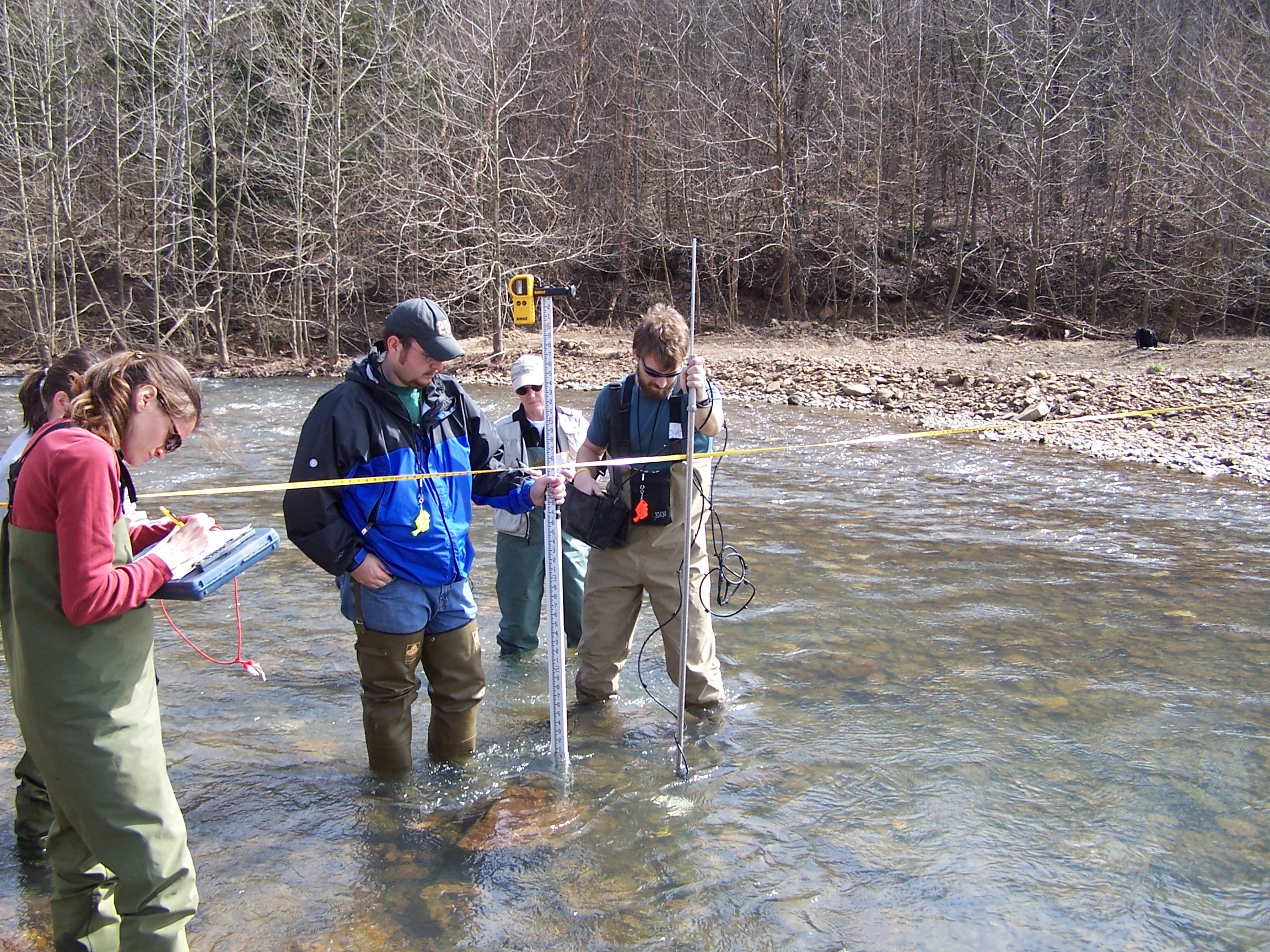Researchers Sculpt Streams to Create Desirable Environmental Outcomes

Students in ecological engineering professor Marty Matlock's fluvial mechanics class at the University of Arkansas measure the properties of Wharton Creek.
FAYETTEVILLE, Ark. — Ecological engineering professor Marty Matlock has given his students an unusual assignment: He wants them to re-design a river.
This project requires research that co-leaders Matlock and R. Michael Hanley, an ecosystem restoration engineer with The Nature Conservancy believe can be applied to other stream ecosystems nationwide.
“It’s about taking these ecosystems and trying to restore them to meet human needs and desires,” Matlock said. These desires include having clean water, preserving animal habitat, restoring wetlands, and creating spaces for natural beauty and recreation.
Restoring a stream is a complex process involving expertise in geology, ecology, hydraulics, hydrology and chemistry. Fluvial mechanics, or the study of water flow energy, also is crucial to understanding and designing these complex systems.
By studying the historic and current patterns of water flow and asking questions about desirable outcomes, Matlock and his students can re-design a stream to meet human needs in a sustainable fashion. Those needs will vary with each stream.
“There’s no one right answer,” Matlock said “A stream can be a thousand things and still be a stream.”
The students in this graduate-level class are working with a landowner along a mile-long stretch of Wharton Creek, a tributary of War Eagle Creek located near Kingston, Ark.
They have spent Saturdays in and around the creek, taking measurements, determining the dimensions of the stream and the size of the particles in the stream bed. By examining the bedrock and sediment, the erosion and flood plains, they will be able to create a history of what the channel has done.
“We’ve changed the way waters flow over the land,” Matlock said. Streams always have changed within certain boundaries — floods, droughts and other natural processes have shaped those boundaries for millions of years. However, humans have stretched those boundaries past their natural limits with logging, planting of non-native crops, grazing, urbanization and other land-use changes. And these changes sometimes have brought about undesirable effects.
Impacted streams have more erosion power, causing land loss. Important species, such as smallmouth bass, have disappeared from native habitats. Frequent flooding has led to more sediment movement, which adds more fine silt to the human water supply.
On Wharton Creek, for instance, clearing land and mining gravel from sand bars and riffles have changed the water’s flow. The channel has deepened and floods have become more powerful, causing land loss and sweeping sediment downstream towards the lake, carrying excess fertilizer from fields with it.
“Humans depend upon water systems to be static. But we do things that make them more dynamic,” Matlock said.
Once the students have determined the past and present dynamics of the stream ecosystem, they will begin designing the restoration process based on the desired outcome for the stream.
“You have to answer the question, what do you want the system to do?” Matlock said. “You can never restore streams to what they once were. But some of the things that were, we want back.”
In the case of Wharton Creek, the desired outcome may include restoration of smallmouth bass habitat, minimizing land loss and keeping sediment and gravel from being swept downstream. To do this will require many detailed steps, including restoring sinuosity to the stream, creating riffles and pools, planting native trees and grasses along the river banks and restoring the channel to its natural energy level.
In the course of working to restore streams, Matlock, Hanley and the students work with many people in the community, including the director of environmental compliance for the Beaver Lake Water District, the local director of the Northwest Arkansas Chapter of the Audubon Society, the Arkansas Soil and Water Conservation Commission, the Arkansas Game and Fish Commission, and county and city governments. Indeed, The Nature Conservancy’s Hanley drives up from Mississippi each Thursday to co-teach the class, because he believes it is such an important way to develop the skills of future ecological engineers who will in turn make a difference in communities nationwide.
“If we’re going to live on the landscape in a way that allows future generations to continue to use it, we need to have this kind of community engagement,” Matlock said.
Contacts
Marty Matlock, associate professor, ecological engineering (479) 575-2849, mmatlock@uark.edu
R. Michael Hanley, riverine ecosystem restoration engineer/fluvial geomorphologist, The Nature Conservancy-southern U.S. region (501) 519-2517, mhanley@tnc.org
Melissa Lutz Blouin, science and research communications manager (479) 575-5555, blouin@uark.edu
Headlines
Four Students Named Goldwater Scholars; Two Earn Udall Honorable Mentions
Four U of A students have received the prestigious Goldwater Scholarship, an award for top students in mathematics, science, and engineering.
Cross-Campus Collaboration Culminates in New Outdoor Geological Installation
Grand opening event to celebrate the new GeoLab installation at the U of A’s Gearhart Hall courtyard is set for May 3. The installation will be open to the public year-round.
First Students to Use Online Degree to Hone Nursing Leadership, Elevate Patient Care
Hanna Baxendale and Wendi Kimbrell will begin coursework in the Doctor of Nursing Practice-Executive Master of Business Administration program offered by the Eleanor Mann School of Nursing and Walton College.
Join the Office for Sustainability on a Final Cruise to Campus
Cruise to Campus Wednesdays have fostered a gathering space for individuals interested in biking to campus. Drop by the Old Main Lawn from 7:30-10 a.m. Wednesday for coffee, something to eat and conversation.
Fay Jones School Student Ambassador Program Gives Voice to Design Students
The student ambassador program at the Fay Jones School of Architecture and Design is built to connect top design students with their school, its alumni, its future students and others inside and outside the school.






